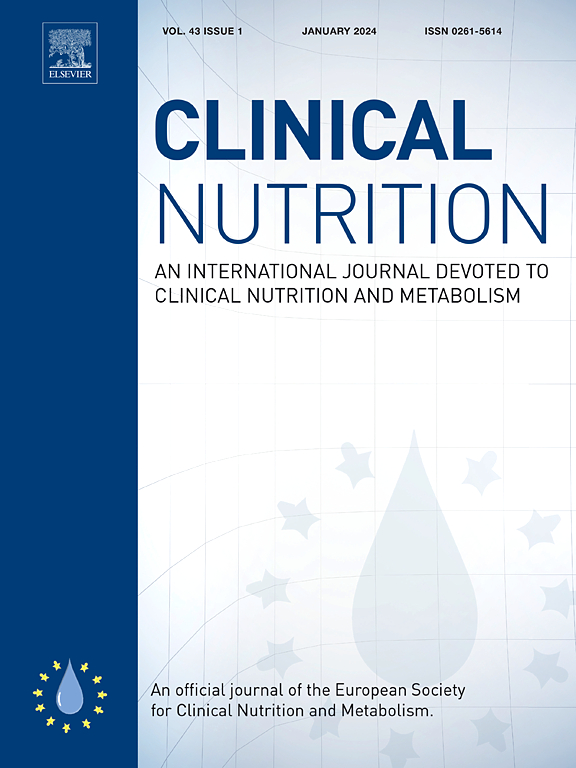30万成年人正常体重肥胖亚型与主要血管疾病的10年风险
IF 6.6
2区 医学
Q1 NUTRITION & DIETETICS
引用次数: 0
摘要
背景与目的:肥胖直接促进心血管疾病的进展,但正常体重肥胖亚型与主要血管事件(MVEs)及其亚型的发病率的关系和风险归因知之甚少。方法:基于中国嘉道理生物库(CKB)的前瞻性队列研究。在基线时,共有308071名没有既往血管疾病或癌症的个体被纳入研究。随访期间记录MVEs的发生率及其亚型。通过Cox回归得出每种疾病的校正风险比(hr)。结果:在中位随访10.3年期间,共发生62,040例MVEs,正常体重一般肥胖(NWGO)调整后的HRs(95%可信区间)为1.11(1.09-1.13),正常体重中心型肥胖(NWCO)调整后的HRs为1.27(1.23-1.31),正常体重中心型和一般肥胖(NWCGO)调整后的HRs为1.30(1.27-1.33)。对于MVEs亚型,腰围(WC)增加与缺血性心脏病(IHD)的过度风险相关,与体脂率(BF%)水平无关(男性HR范围:1.30-1.69;女性为1.36-1.55),而在每个WC四分位数内,随着BF%的上升,风险趋于稳定。然而,即使在腰围较低(≤78 cm[中位数])的男性中,脑血管疾病(CeVD),特别是缺血性卒中(IS)的风险也随着BF%的增加而增加(均为P)。结论:本研究提供了新的、性别特异性的证据,证明正常体重肥胖亚型与MVEs亚型的不同风险相关,女性的风险升高主要归因于WC,男性的WC和BF%。本文章由计算机程序翻译,如有差异,请以英文原文为准。

Normal-weight obesity subtypes and 10-year risks of major vascular diseases in 0.3 million adults
Background & aims
Obesity directly contributes to the progression of cardiovascular disease, but little is known about the association and risk attribution of normal-weight obesity subtypes with the incidence of major vascular events (MVEs) and their subtypes.
Methods
This is a prospective cohort study based on the China Kadoorie Biobank (CKB). A total of 308,071 individuals with no prior vascular diseases or cancer were included at baseline. The incidence of MVEs and their subtypes were recorded during follow-up. Adjusted hazard ratios (HRs) for each disease were yielded by Cox regression.
Results
During a median follow-up of 10.3 years, 62,040 MVEs occurred, with the adjusted HRs (95 % confidence intervals) were 1.11 (1.09–1.13) for normal-weight general obesity (NWGO), 1.27 (1.23–1.31) for normal-weight central obesity (NWCO), and 1.30 (1.27–1.33) for normal-weight central and general obesity (NWCGO). For subtypes of MVEs, increased waist circumference (WC) was associated with excess risk of ischaemic heart disease (IHD) independent of body fat percent (BF%) levels (HR range: 1.30–1.69 in men; 1.36–1.55 in women), while the risk plateaued with rising BF% within each WC quartile. However, even in men with lower WC (≤78 cm [median]), the risks of cerebrovascular disease (CeVD), particularly ischaemic stroke (IS), were increased with higher BF% (all P < 0.01). Conversely, in women, independent dose–response associations were primarily observed between increasing WC and CeVD, with the highest risk observed for IS (HR 1.38, 1.31–1.47).
Conclusions
This study provided novel, sex-specific evidence that normal-weight obesity subtypes were associated with distinct risks of subtypes of MVEs, with elevated risks predominantly attributable to WC in women and both WC and BF% in men.
求助全文
通过发布文献求助,成功后即可免费获取论文全文。
去求助
来源期刊

Clinical nutrition
医学-营养学
CiteScore
14.10
自引率
6.30%
发文量
356
审稿时长
28 days
期刊介绍:
Clinical Nutrition, the official journal of ESPEN, The European Society for Clinical Nutrition and Metabolism, is an international journal providing essential scientific information on nutritional and metabolic care and the relationship between nutrition and disease both in the setting of basic science and clinical practice. Published bi-monthly, each issue combines original articles and reviews providing an invaluable reference for any specialist concerned with these fields.
 求助内容:
求助内容: 应助结果提醒方式:
应助结果提醒方式:


